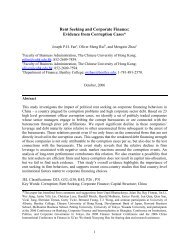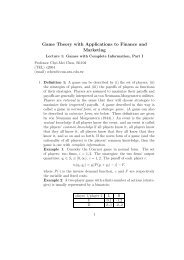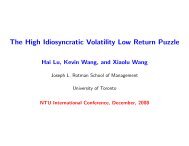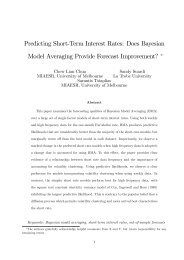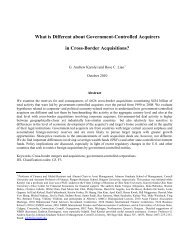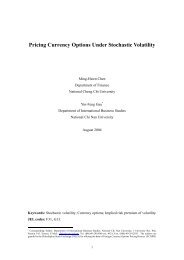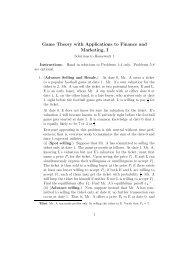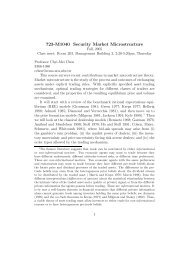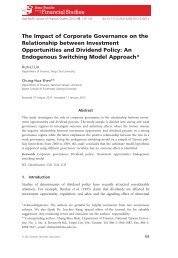Game Theory with Applications to Finance and Marketing
Game Theory with Applications to Finance and Marketing
Game Theory with Applications to Finance and Marketing
Create successful ePaper yourself
Turn your PDF publications into a flip-book with our unique Google optimized e-Paper software.
show that the unique equilibrium in mixed strategy is such that 13<br />
⎧<br />
0, x ≤ p ≡ αV ; 1−β<br />
1− ⎪⎨<br />
p x<br />
, x ∈ [p, v);<br />
1−<br />
F A (x) =<br />
β<br />
1−α<br />
1− p v<br />
, x ∈ [v, V );<br />
1−<br />
⎪⎩<br />
β<br />
1−α<br />
1, x ≥ V,<br />
(9)<br />
13 Let us demonstrate in detail how <strong>to</strong> get this equilibrium.<br />
• At first, the supports of F A <strong>and</strong> F B must share the same greatest lower bound<br />
p j+p<br />
p, because given p i<br />
, each p j < p i<br />
is strictly dominated by, say, i<br />
2<br />
, for i ≠ j,<br />
i, j ∈ {A, B}. Note that p > 0 because both firms can ensure a strictly positive<br />
profit by serving their own loyals only.<br />
• Second, in equilibrium at least one firm i must price at V <strong>with</strong> a strictly positive<br />
probability. To see this, define p j ≡ sup{p j : p j ≤ v} <strong>and</strong> suppose instead that<br />
F A (v) = F B (v) = 1, <strong>and</strong> we shall demonstrate a contradiction. We first claim that<br />
p A = p B = p: any p j ∈ (p i , p j ) would otherwise be dominated by V . Next, we claim<br />
that neither F A nor F B can have a jump at p: if ∆F i (p) > 0 then firm j would rather<br />
price at p − ɛ than at p, for some sufficiently small ɛ > 0, <strong>and</strong> hence ∆F j (p) = 0, but<br />
then pricing at p is dominated by pricing at V from firm i’s perspective! Now, by<br />
the fact that F A <strong>and</strong> F B are both continuous at p, again, p must be a best response<br />
because for some δ > 0, every price contained in (p − δ, p) is a best response (cf.<br />
Lemmas 4 <strong>and</strong> 6), but it is clear that pricing at p is still dominated by pricing at<br />
V from each firm’s perspective! We conclude that a contradiction would always<br />
arise unless at least one firm will price at V <strong>with</strong> a strictly positive probability in<br />
equilibrium.<br />
• Third, for i = A, B, we must have p i = v. Again, it must be that p A = p B = p:<br />
any p j ∈ (p i , p j ) would otherwise be dominated by V . Recall also that neither F A<br />
nor F B can have a jump at p: if ∆F i (p) > 0 then firm j would rather price at<br />
p − ɛ than at p, for some sufficiently small ɛ > 0, <strong>and</strong> hence ∆F j (p) = 0, but then<br />
pricing at p is dominated by pricing at v+p<br />
2<br />
from firm i’s perspective! By definition<br />
of the least upper bound, there exists an increasing sequence of pure-strategy best<br />
responses {p n i ; n = 1, 2, · · ·} converging <strong>to</strong> p, which, by the fact that F A <strong>and</strong> F B<br />
are both continuous at p, implies that the limit p is also a best response from both<br />
firms’ perspective. However, pricing at p is apparently dominated by pricing at v<br />
from each firm’s perspective, which is a contradiction.<br />
• Fourth, firm i’s equilibrium payoff (expected profit) is Π i = α i V if <strong>with</strong> a strictly<br />
positive probability it may price at V . This pins down p as follows. Note that for<br />
all x ∈ [p, v),<br />
Π i = α i V = x{α i + (1 − α i − α j )[1 − F j (x)]} ⇒ F j (x) = 1 −<br />
− α i<br />
,<br />
1 − α i − α j<br />
which, by the fact that F j (p) = 0, implies that<br />
p 23 =<br />
α iV<br />
.<br />
1 − α j<br />
The question is which firm will price at V <strong>with</strong> a strictly positive probability. Recall<br />
that the firm <strong>with</strong> a larger loyal base cannot compete as aggressively as its rival<br />
α iV<br />
x



